Well-known for its ancient temples, stunning landscapes, and friendly people, Myanmar is truly an incredible place to visit. The country was on my travel list for a long time and I was extremely happy to come here for the first time some years ago, just when it became more accessible for tourists.
If your idea of having a good time includes experiencing authentic culture and exploring low-key destinations away from the tourist hordes, Myanmar is definitely the place you want to go to.
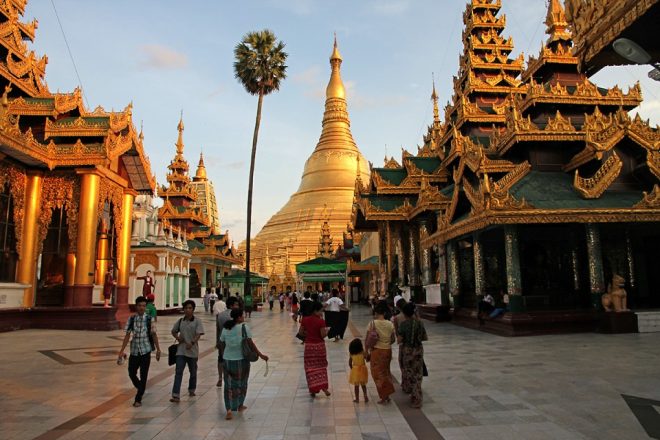
Should you travel to Myanmar?
The truth is that Myanmar is known for its troubled history as well as more recent political issues. The country used to be run by a military dictatorship while the democratically elected leader Aung San Suu Kyi spent a significant amount of time under house arrest.
There is also the issue of racially-fuelled violence against the country’s Rohingya Muslim population. About 625,000 refugees from Rakhine, Myanmar were forced to leave their homes and cross the border with Bangladesh during the 2016–17 crisis.
Whether you feel this is a reason not to visit Myanmar is ultimately a personal decision. There’s been plenty of debate on this among travel bloggers, with many people passionately arguing for both sides. In this post, I’ll stay neutral in this matter, while respecting both perspectives.
However, safety is not an issue for tourists. In 2012, the international bans were pulled and foreigners started traveling to Myanmar. Authorities don’t allow tourists anywhere near any danger and despite all the negative coverage, most people in Myanmar have nothing to do with the politics and the country itself is very safe to travel.
During my visit to Myanmar, I discovered that petty crime and scams are very rare. Due to having been fairly isolated for many decades, there is generally a very welcoming and uncynical attitude towards tourists.
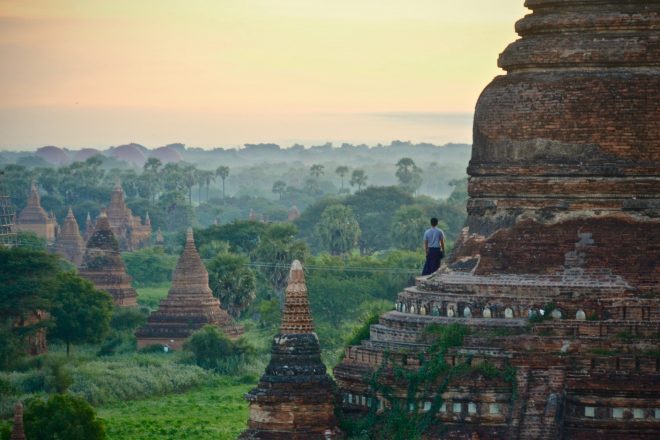
Why go backpacking in Myanmar
Myanmar is definitely one of the least visited countries in Southeast Asia, but maybe that’s what makes it so special and unique. If you wish to get a break from hyper-touristy destinations in Asia like Thailand, you’ll be happy to hear that Myanmar is a relatively unexplored destination. There are no overcrowded beaches here, everything (except hotels) is dirt cheap, and the locals don’t treat you as an ATM.
While backpacking Myanmar, you will have an opportunity to visit dozens of seriously awesome places!
From Inle Lake which is one of the most stunning lakes in the world to the temple complex of Bagan where you will find over 2,000 Buddhist pagodas and temples, there are plenty of interesting destinations in Myanmar just waiting to be explored.
Get lost in the chaotic streets of Yangon and admire the capital’s cool golden temples or pay a visit to Kyaikto which is home to a unique Buddhist pilgrimage site. If you wish to get away from it all and find some peace, I recommend spending a few days in the quiet town of Hsipaw or visiting the small beach towns of Chaungtha and Ngapali.
Is it Myanmar or Burma?
Let me start by saying that no one’s going to give you the stink eye for using these country names interchangeably. This South Asian country had its share of ups and downs, so it comes as no surprise that all of that leads to a bit of a dual identity.
On paper, the country is called Myanmar, but many people still refer to it as Burma.
It was back in 1989 when the military pushed aside General Ne Win’s government and decided to change things and rename the country from Burma to Myanmar. While they were at it, they also changed the name of the capital city of Rangoon to Yangon. Why? They wanted to give a national identity to other ethnic groups apart from Burmans and to get rid of the British colonial influence.
Nowadays, there is not much fuss about all of this and most people use both names.
Travel limitations in Myanmar
In the past, travel in Myanmar was fairly restricted due to the political situation. Fortunately, things have changed a lot in the last 10 years and these days backpackers can explore most parts of the country.
However, the northern parts of Myanmar including places like Kachin state, Southern Chin and Rakhine are off-limits to tourists for safety reasons. Therefore, going truly off the beaten path in Myanmar can be difficult. On the map below you can see some of the common tourist highlights where you can definitely travel unimpeded.
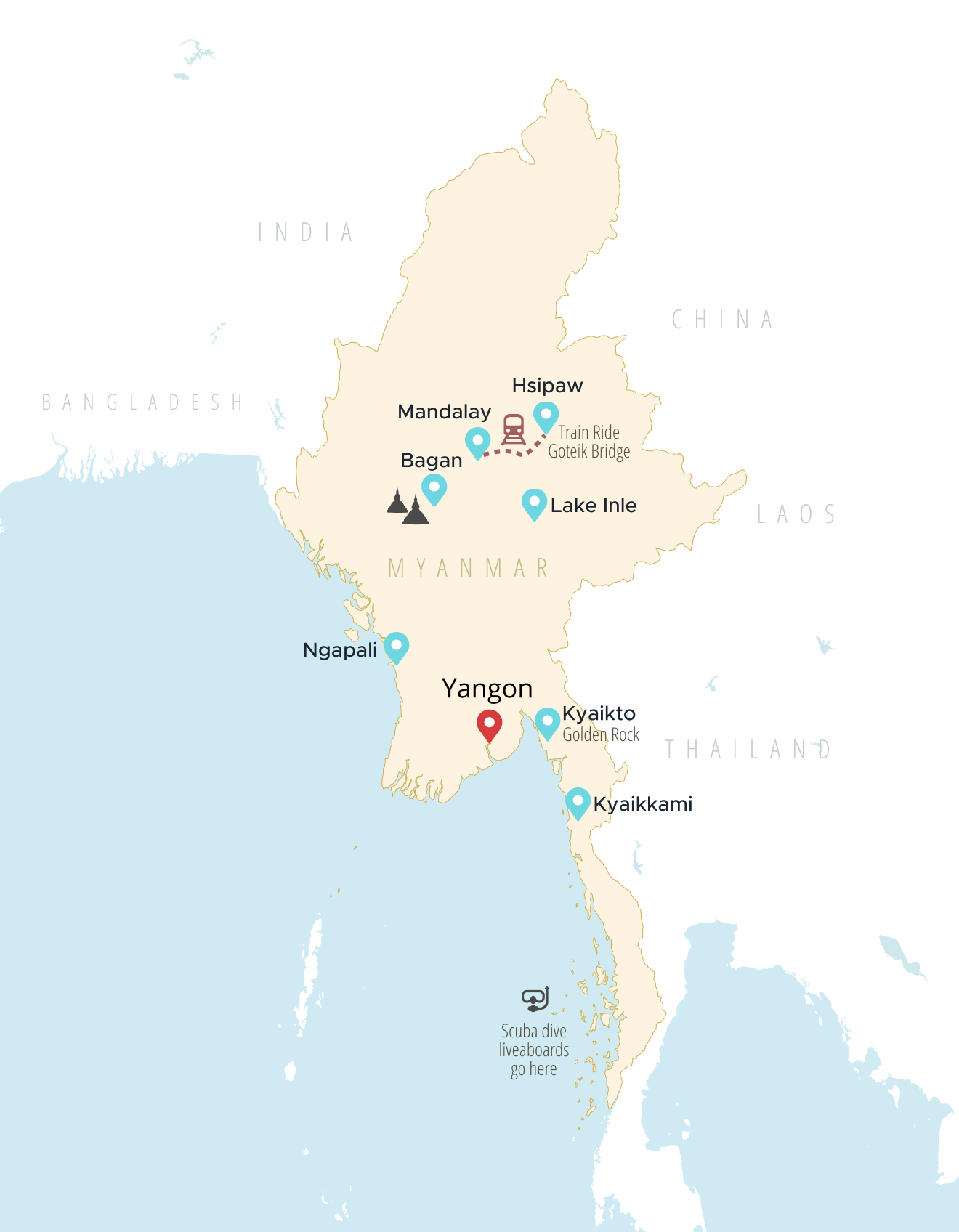
In Thailand, you can pretty much go anywhere you like as a traveler. In Myanmar, it’s best to stick to your average backpacker route and stay away from the northern parts. I mean, even if you try to reach these northern states, you will be stopped by the authorities at some point. Since the accessibility of different areas in Myanmar changes every year or so, it’s always best to check the government website for fresh information and updates.
Entry points to Myanmar
Getting into Myanmar is quite easy. There are many flights from South Asian countries to the capital city of Yangon, but you can also opt for flying into Mandalay which is also served by numerous airlines.
Backpackers who wish to travel overland should know that it is possible to cross Myanmar’s borders with India and Thailand. The borders with China and Bangladesh are closed to foreigners, while the border with Laos is remote and you need some special permission from the authorities to cross it. There were recent reports in the local press saying how the border between Laos and Myanmar is now open to foreigners, but local expats write that it is still not possible to cross this border as a foreigner.
There are three border crossings between Myanmar and Thailand:
- Mae Sot – Myawaddy (central). This is the easiest way to get from Bangkok to Yangon, and by far the most popular crossing due to its proximity to various places of interest in Myanmar. Ignore any advice that says this crossing is one-way only; this is not the case anymore since a new road was completed in 2016.
- Phunaron – Htee Kee (central). Buses go from Kanchanaburi in Thailand to the small border town of Phunaron. It’s a small and remote crossing and on a slow mountain road, though it’s fully accessible.
- Ranong – Kawthaung (south). This crossing lets you enter Myanmar from the far south. The roads here are reportedly rough, and in bad weather conditions overland travel to Myeik may not always be possible.
There is also the Mae Sai – Tachileik border crossing near Thailand’s Chiang Rai province, but you’ll get stuck if you don’t have a permit to travel further overland which is rarely issued. This crossing is, broadly speaking, not usable for independent travelers intending to go into Myanmar overland without restriction.
Two open border crossings are connecting Myanmar and India which are open to foreigners. One is Moreh/Tamu, while the second one is Zokhawtar/Rikhawdar which puts you close to one of the most beautiful mountainous regions in Myanmar and the incredible heart-shaped Rih Lake.
Visa process in Myanmar
You will need a visa to enter Myanmar, but the whole process is relatively easy. The good news is there an official e-Visa website and you can apply for your visa to Myanmar online. All you need to do is pay the $50 fee, upload your passport photo, and specify a port of entry in your application.
On the website, it says you should get your visa approval within 3 working days, but in many cases, it takes less time to obtain the visa. Your e-Visa is valid for 3 months from the date of issue and allows you to stay in Myanmar for 4 weeks.
Top places to visit in Myanmar
Yangon
Among the main attractions in Yangon is the Shwedagon Pagoda, a huge gold-roofed Buddhist temple. Sunset is an excellent time to go as the dome will be gleaming beautifully in the orange sun.
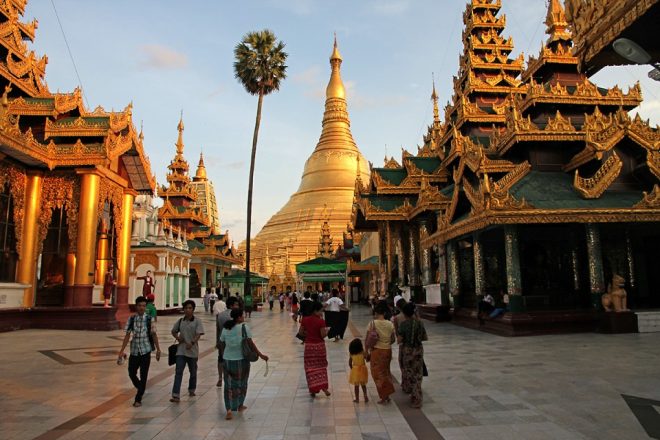
Apart from the pagodas, some people might feel that Yangon is not particularly rich in major ‘sights’ or museums, but I think there’s plenty to experience. You can have a wander through the streets and markets, or sit down in a tea house and watch people go about their business. Chinatown is a great area for street photography or to sample some very yum street food.
Interestingly, motorbikes are outlawed in Yangon. According to rumor a well-placed individual in the army had once been in a motorbike related accident, and then decided the city could just as well do without them. I am not sure if this is exactly how this law came to be, though it has resulted in the streets of Yangon having a relatively quiet and pleasant character.
Mandalay
Mandalay is the second largest city, and it’s mainly a great base for daytrips to various sights in the area. You can take a taxi or rent a scooter and make your way to the U Bien Bridge, Myanmar’s iconic 2.5 km long teak bridge across a lake, which is also the cover image of many Myanmar guidebooks. Another popular sight is Mandalay Hill, which has some great viewpoints where you can see the entire city below.
With lots of motorbikes and many power generators set up outside of buildings (as backups for use during power cuts), Mandalay is not quite as walkable or as tranquil as Yangon. Still, there is a lot of interesting city life to see here, and you’ll find various markets with great Burmese street food.
Bagan
With over 200 temples dotted around the landscape, Bagan is quite the sight. You can explore the area on your own by foot or by renting bicycles, or get a guide with horse carriage to ride you around.
A few of the temples you can climb on top of, and these make for perfect viewing points at sunset. Don’t miss this spectacular panoramic view! (It’s easiest to ask your guide or hostel where these particular temples are.)
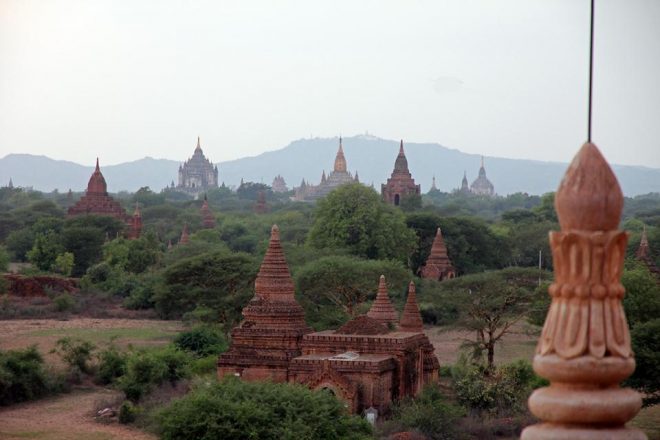
Seen as a whole the temples of Bagan are especially impressive, though it’s maybe worth saying they’re fairly identical when exploring up-close, and many of the temples are essentially empty inside. By the time you’ve seen your tenth temple you’ll probably be ‘templed out’, but I’m only saying that to temper expectations slightly. You can easily spend a full day exploring the area.
Lake Inle
Lake Inle is the second big attraction in Myanmar after Bagan, though unlike the rest of the country things can feel decidedly inauthentic here. If you go on one of the boat tours, you’ll likely be dropped off at various tacky souvenir shops. Some of these shops have a member of the long-neck Karen tribes almost as a kind of human display. While the lake is beautiful, it’s becoming full of noisy longboats and there have been alarming reports about the ecological impact of tourism on the lake. Maybe these boat tours can be skipped. (They’re not so special anyway.)
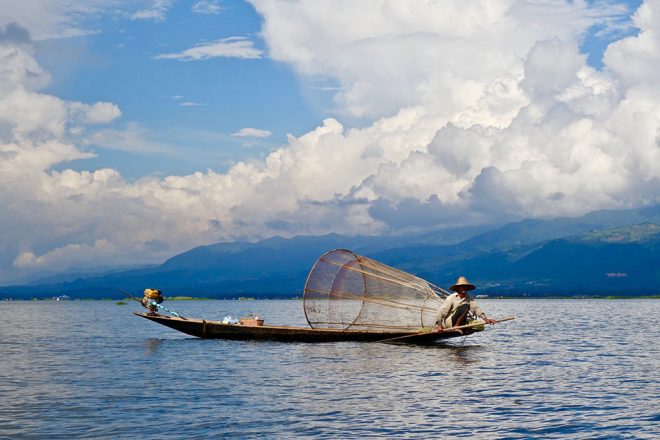
The town of Nyaung Shwe is the main travel hub in this area from which to go on excursions. A worthwhile trip is to Inthein, a sort of mini version of Bagan. The hundreds of small crumbling temples and stupas here are overgrown with gnarly trees and foliage, giving these ruins a bit of an Indiana Jones feel.
A good way to see the beautiful nature near lake inle—and much less tacky or invasive than the boat tours—is to go on a trek. I did a 2 day trek from the town of Kalaw to Nyaung Shwe which was very enjoyable.
Train to Hsipaw
Riding a train in Myanmar is quite the experience! If you find enjoyment just in the act of traveling itself, I recommend taking a train in Myanmar at least once.
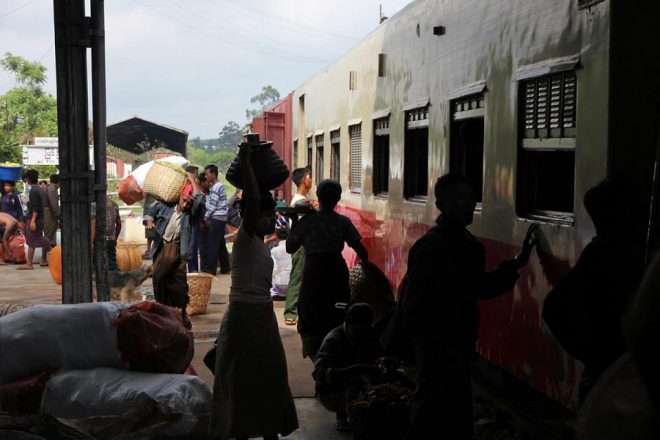
A popular route is the circle line in Yangon and you can read a great report about this on the blog Borders of Adventure.
Another recommended journey is the one between Mandalay and Hsipaw. You can get a minivan or taxi to the town of Pyin Oo Lwin first and then get on the train in the early morning, so you can catch the best part of the route.
It can be an uncomfortable journey though. If you are prone to motion sickness, the extreme swaying from side to side could easily trigger it.
The train crosses a canyon via the Goteik viaduct which was built during British colonial times. While crossing this bridge was not quite as thrilling as the guidebooks made me believe, this journey is more about seeing the beautiful landscapes passing you by.
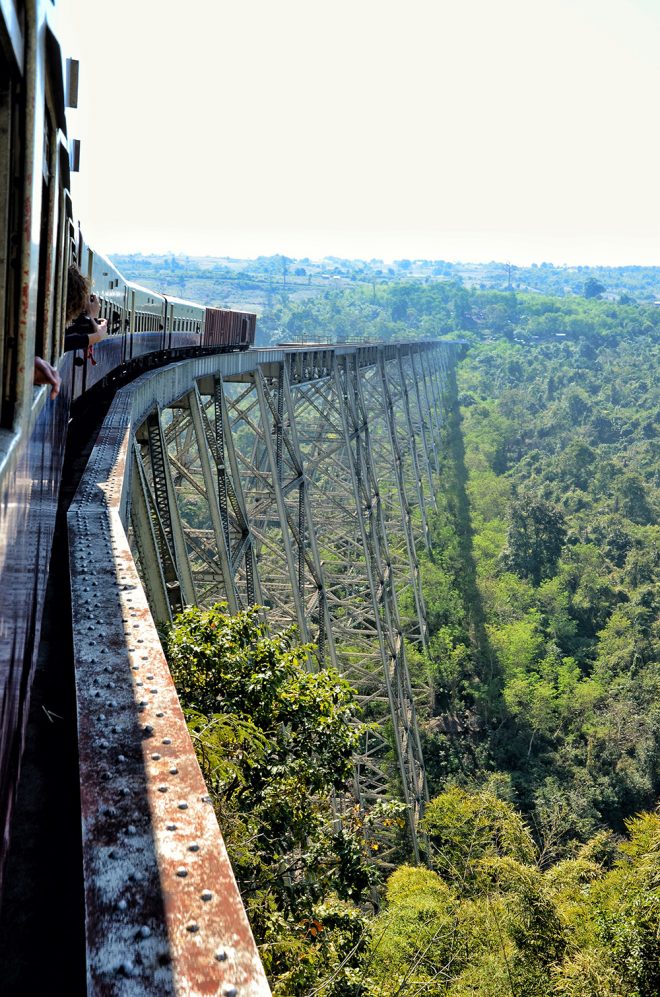
It might also be just about the physical experience of being on a super old train. When it picks up speed you will surely be bouncing around the cabin, and you do have to watch your head if you’re near an open window as the trees and bushes get very close. At certain points during my ride, the train basically turned into a giant hedge trimmer cutting through the jungle, spraying leaves and branches into the carriage through the open windows.
Hsipaw is a great base for hikes in the area east of Mandalay. Since it’s at a higher altitude, it’s pleasantly cooler here compared to Bagan or Mandalay.
Kalaw
Located just 50m km from Inle Lake, Kalaw is a lovely town and serves as an ideal base for the famous Kalaw-Inle Lake hike. Check out the local market where you can try the traditional shan noodles and purchase a bottle of local wine. There is also a nice spa and wellness center located just a short walk from the train station. They offer everything from massages to foot scrubs and manicures at a fair price.
Many backpackers spend only one night here before going on a three-day hike to Inle Lake. The trek has become popular over the last couple of years and allows you to admire the beauty of the surrounding mountains and see the small picturesque villages along the way.
Ngapali Beach
If spending a couple of days on stunning beaches in a tranquil environment sounds like something you would enjoy, I recommend paying a visit to Ngapali Beach. You can go on fishing trips from the beach or join one of the boat tours.
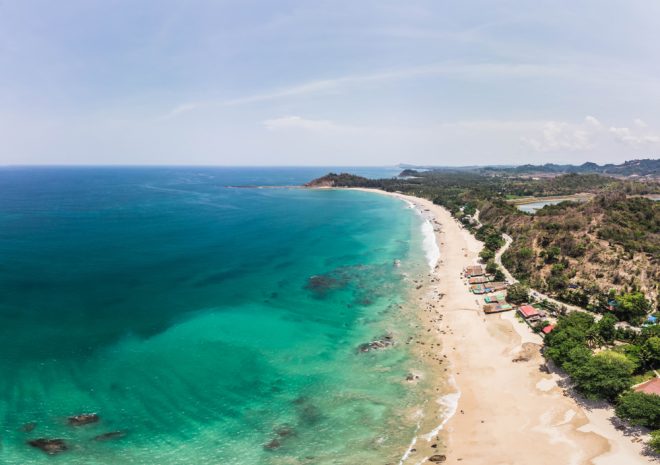
The only downside is that accommodation can be expensive here, but you can always go down the coast to places like Ngwe Saung where it’s easier to get better deals. Keep in mind that from May to October it’s not recommended to visit the beach because of the monsoon season.
Kyaikto
A part of the Kyaikto Township in Thaton District, Kyaikto is an ideal base to see the Golden Rock which is one of the most famous landmarks in the country. You can climb the mountain in about 45 minutes to see the Golden Rock (Kyaiktiyo Pagoda), a well-known Buddhist pilgrimage built on the top of a granite boulder.
Mount Popa
Rising about 1,500 meters above sea level, Mount Popa is a great place to visit while backpacking through Myanmar. Located in Mount Popa National Park, this place is actually an extinct volcano with a lovely monastery on the top.
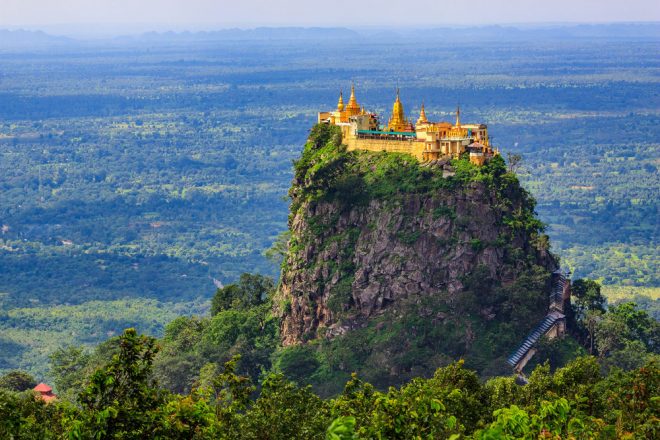
There are 777 steps to climb to reach Mount Popa. Luckily, the stairway to the top is covered and along the way, you will come across many locals selling everything from flowers to wooden handicrafts. There are also many monkeys along the staircase and what’s even better; you can see them in the monastery itself. The views from the top are breathtaking. If the weather is nice, you can see the Irrawaddy River from the top of the mountain.
Cost of travel in Myanmar
You will be happy to hear that backpacking Myanmar is not expensive at all. The accommodation is affordable, the food is cheap, and the transport is reasonably priced.
Accommodation costs
Expect to pay around $15-$20 a night for a dorm bed, while basic private rooms can set you back around $30. Of course, the price depends on which part of the country you are visiting. In tourist destinations like Ngapali beach, accommodation is a bit on the expensive side. If you are visiting small towns, you can even get a dorm bed for as little as $10 per night.
Accommodation tends to cost a bit more in Myanmar than other neighboring countries. One reason for this is that the country was so isolated for so long, that there just wasn’t much need for that many hotels or hostels. Myanmar had to play catch-up, so prices are a bit higher.
Transportation costs
The cost of traveling from town to town in Myanmar is relatively cheap. Expect to pay around $6 for a bus ticket from Bago to the Golden Rock, while a ride from Mawlamyaing to Yangon will set you back $9. If you wish to go with a car from Sittwe to Mrauk U, expect to pay around $50 which is not that expensive if you find 2 or 3 other travelers to share the cost.
Costs for admission
Many historical sites have charge admission in Myanmar. For example, the entrance to Shwedagon Pagoda costs $8 and for the Golden Rock $6. Small temples usually charge a $1 fee. To enter Bagan, you will need to set aside $15.
Food costs
Street food in Myanmar is extremely cheap. You will pay around $1-$2 for a basic meal. In local restaurants, the meals are usually around $3. I liked the fish soup with rice noodles that they call Mohinga. Burmese curry is also delicious and usually comes with chicken, beef, or pork. Make sure to try the deep-fried stuffed tofu which is made in a special sauce and served with cabbage and chilies.
Some links may be affiliate links, meaning I may earn commission from products or services I recommend. For more, see site policies.
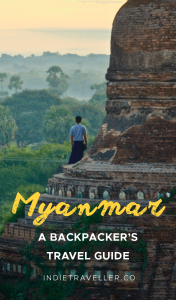
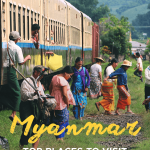
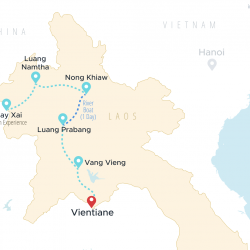
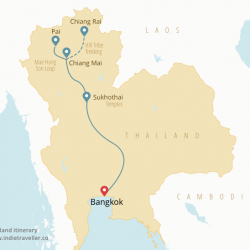




Thank you so much for this article. Just one question – how easy is to acess Laos from Myanmar by land? Will I have to go by Thailand? Thanks
There is no open border crossing from Myanmar to Laos, so unfortunately you’ll have to go via Thailand. Coincidentally, I just came to Laos a few hours ago from Thailand at Huay Xai… they have a new bridge and immigration here which makes it all very easy. 🙂
Hi Mark, have you seen mom and a child (6 years old) travleing there? Do you think is it safe? Thanks in advance
Have not specifically met a mother with child travelling in Myanmar but have in other nearby countries (Malaysia etc.). Yes I think Myanmar is safe (speaking for all of the touristed areas).
Great article, thanks for the tips! With the spectacular temples of Bagan, stunning Mandalay with lakes, pagodas, and palaces, lively markets and a delicious street food scene, Myanmar is a joy to visit. However, with the rise of tourism, cases of tourist targeted scams have risen as well.
Do be wary of the shoe guardians, friendship tour scam, restaurants without set prices, coin collectors, fake entrance tickets, pickpocketing, snatch thefts and many more!
Hi Marek,
Thanks for the very helpful and informative post for travelling to Myanmar. I am now in Bangkok and planning to visit Myanmar for about 7-10 days. I have about 9000-10000 baht with me now, and I hope not to withdraw cash again in Myanmar (cause don’t want to pay oversea ATM fee etc again )
I read that I can’t get Kyat outside Myanmar, and it’s not common to change Baht to Kyat when I get into the country. Should I just change the amount that I think I will spend for the whole trip from baht to US dollar now ? Or it is possible to change Baht to Kyat when I am there?
Thank you for your advice!!
Hey Natsu. I believe Baht is not widely accepted for exchange in Myanmar, though this was some time ago now and to be honest I don’t know if this is still the case. If you exchange to USD in Thailand, you’ll be able to exchange this to Kyat for sure though. You’ll be hit with two exchange fees in that case, but it’s probably worth it just to remove the uncertainty.
Kyat typically can’t be exchanged anywhere outside of Myanmar btw, so be sure to spend it all or exchange what you’ve got left back to USD or Baht.
Not problem. Baht is accepted in exchange counters in Myanmar.
Great post – so informative.
Can I ask advice? I’m a black female and intend to go to Myanmar – will it be safe for me to do so on my own?
Thank you!
Hey Catherine. As far as solo female travel goes, yes – it’s a safe country and even petty theft is very rare. As far as race goes, as a white guy I might not be the best authority on this. That said, I’m not aware of issues within Myanmar apart from occasional awkward staring at international visitors (mostly in rural places where this is still a novelty).
The temples at Bagan are so beautiful, thanks for sharing!
I’ve been looking into Myanmar and seems like there’s really no way around the accommodation prices but to book early. I enjoyed reading through your write up, thanks!
Every time I have found some new massage from your blog!I am a traveler and dreaming of visiting most historical places in the world.Thanks, dear your great help and keep it up.
Hi Marek! As what I have read before, they only accept pristine US dollars on money changer. Is it still applicable nowadays? My friend and I will be travelling March 2017 and we are thinking which way would be better, bring dollars or just withdraw Kyats through ATM’s? I am also thinking of splitting the budget to $ and ATM’s but which should I have more. Thanks! More power!
Hey Mark! ATMs are now plentiful in Myanmar so you can rely on them a lot more, particularly if you’re sticking mostly to the tourist trail such as the places mentioned on this page. Maybe call your bank and check to make sure if your debit card will work there (just because I’ve heard some rare anecdotes of people having trouble). Cash USD still needs to be crisp to exchange it – I would probably bring a smaller portion of your budget in USD, mostly as a backup. I personally do this anyway when travelling anywhere in Southeast Asia.
Thanks for this great blog. A helpful addition might be that although the visa is statiny otherwise, the immigration officers don’t really seem to care whether you have an departure ticket booked or not. Me and some other travellers had not, which wasn’t a problem, even when we asked.
Ps. 3G internet works pretty well in the cities at least and a SIM with 2Gb for a month costs 11.500 kyat.
Great info, thanks for sharing!
Hi there, we are planning our honeymoon in south east asia with Myanmar as our first country. We have booked our tickets to arrive in Yangon. We also want to see Mandalay, Bagan and Lake Inle. We wanted to go to Laos after Myanmar but I am so confused with the travels.
I am wondering about the visa on arrival situation. We can get an eVisa but do we need our departure tickets out of Myanmar in order to get a Visa? And for travelling to Laos from Myanmar; are there no flights direct there? And is there really a way to get from Mandalay to Laos overland?? Is it safe for two Canadian travellers???
Any information would help!
Thank you !
Travelling overland from Myanmar to Laos directly is currently not possible. The only way would be to cross the border overland to Thailand and go through Thailand from there. Flight connections with Myanmar remain pretty limited and the only connections to Mandalay I’m aware of are to Kunming in China and Chiang Mai in Thailand. So you’ll probably have to be a bit flexible around these limitations in order to combine Laos and Myanmar.
For the visa requirements you might be better off checking the official Myanmar sources at the moment as I haven’t looked into the requirements in a while [EDIT: I’ve updated this post with the latest info]. As far as safety goes, this is fortunately not something to worry about. Myanmar is generally a very safe country. 🙂 Hope this helps!
Video of my backpacking trip in Burma: https://www.youtube.com/watch?v=CwoDi8linq4
Dear all traveller
My name is Moonlight,from inle lake.I’m a tour guide from travel company but i become fed up with
this job.So I’ve decided to make own business as a small local travel agent in Nyaung Shwe.I aim to offer the tour for traveller who wants to travel with their budged.So I can organise the tour that is fixed price. just do inquire email-
inlemoonlight@gmail.com
FYI, the dirt-cheap places (as in shared bath or shared rooms) in Yangon are in the center near Sule Pagoda. I always hear people talk about Motherland, but I’m sure there are people like me who prefer central locations. For people with pretty low standards, there’s a place that’s still only $6. The cheapie I’ve used bumped up to $9 after tourists started pouring in (used to be only $4…private fan room no bathroom, but they did improve the shared bath somewhat with the raised price). A private ensuite A/C room in other hotels can be had for $15, though.
Hi, Marek. its possible i’m going to thailand from myanmar, thailand to laos and laos to hanoi? It’s my first time for solo backpacker. Isn’t safe for female alone? I’m going to myanmar in feb 2016
Yes that’s possible, but double check for the Thailand <-> Myanmar part if travelling overland as not all of the land borders between these countries are open. Also keep in mind that Laos to Hanoi takes about 30 hours by bus from Vientiane and is a particularly long/rough journey. Keep enough time in your itinerary for this, or skip it by flying.
No particular safety issues for solo women so long as you take normal care.
I think it is pretty safe in those countries, even Myanmar. Just dont go out when theres no need at 3 o’clock in the morning.
If you are interested, I have Kyats to send to (66350 mmk) worth about $55, I have lost them as I cant exchange them outside Burma. I can send them to your for $40 if you want. That applies to anyone interested. Contact me : jasongabe44@gmail.com . Thanks
Went for 1 month in 2013. It’s an amazing destination. Only negative for me was no cheap accommodations available. Spent previous month in Thailand. It cost me double for hotels & there were no hostile or guest house options in Myanmar.
Great blog! thanks so much for the info. Just wondering if you have any recommendations for companies running treks from Kalaw to Inle Lake? Thanks so much 🙂
Can’t remember who I did my trekking with, sorry! I just found a company locally.
I am planning to travel to Myanmar in the second half of April and into May 2016 – how did you feel about the heat? I have been hearing so many mixed reports on how manageable the heat is. I wasn’t concerned about it, as I was in Cambodia when the heat was intense but the advisories people are giving me are causing me to have a second thought.
I can confirm that it’s scorching in May with temperatures sometimes approaching 40 degrees C. For me, doing active stuff in early morning and having a mid-afternoon siesta was a practical necessity in the central plains (e.g. Mandalay, Bagan, etc.) during this time of the year. Still, it wasn’t unmanageable. If you dealt with intense heat in Cambodia before you probably know what to expect. Also, places like Lake Inle, Hsipaw, Pyin U Lwin and Kalaw are at a higher elevation and have a much more pleasant temperature… so you can always escape the extreme heat there.
I’ve been to Myanmar 5 times, but only once during hot season–not even as hot as the time you’re planning! I was there for the second half of March (2012) and did most of my trekking in higher-altitude parts of Shan State (Kyaukme and Kengtung). Even so, very dusty, dry and pretty hot. Then in Mandalay, Sagaing, Yangon it was only relatively dry-for-the-region (i.e. humid) and very very hot. Just standing around sweating.
Mandalay is usually the most unbearable with heat, it feels like there’s only about 2 weeks of winter there. (There’s maybe 6 weeks in Yangon). Which is not to stay I don’t still love every minute!
Update: you can get tourist visas on arrival through the government website! http://evisa.moip.gov.mm/ I got mine in less than 24 hours, very easy process.
Just about to book my boarding boarding passes to go Myanmar this summer! Any news this 3 years? ahaha
This is very good review for backpackers. I’ve been thinking to open hostel back in my homeland, Myanmar. So, this review gave me something I needed. Cheers.
Great post!
I just returned from Myanmar and loved it so much… Check out my blog for more inspiration and tips: http://bonatravels.com/2015/06/13/country-summary-myanmar/
if i only had 2 weeks in myanmar, where would you recommend i fly in to? and where/ what would you suggest i do? thanks 🙂
Hello, thank you for the useful information.
I am planning to go this May/June, but its only a week trip, flying from Singapore.
Any tips on how to explore Myanmar in short period? which place shall I start first? 🙂
Hi
I just gone back from my Myanmar Trip. Myanmar is so interesting with full of attractions. I stayed in Myanmar for 8days, covering Yangon, Bagan & Mandalay and Inle Lake. It was an unforgotten trip for me. There are so many new hotels and service providers which are value with the money and services. Amonth them, 30th Street Corner Hotel in downtwon and M3 Hotel in Mandalay are the best. These hotels are located very near to the downtown and main attractions. Prices is very cheap although services ans facilitie are the best.
Moreover, there are also cheap full day city tours which costs $15per pax in Yangon, Bagan and Mandalay. It is so nice and i could visit the main destinations of Myanmar, saving my time, money and engery because of this.
Hope my experiences will catch up your needs.
We are a family of 5 travelling to Myanmar in March. We have been told by our travelling agent that we could apply for Visa-on-arrival. You mention above that this is not the case. Do you know if this has changed recently?
I last checked the official sources on this about a month ago. From what I understand visa-on-arrival is still only for business travellers from certain countries. Maybe there’s confusion about the terminology: visa on arrival means you can show up unannounced and just get stamped at the airport. For tourists there is an eVisa program – this is a convenient way to register for a visa, but still requires you applying in advance of your trip.
Thank you for your answer. You were right . we mixed up the visa-on-arrival and eVisa.
I love to visit provinces in the northeast ( Isarn ) like Khonkaen and Sisaket. People are nice and friendly. Interesting culture in Thailand 🙂
Thanks. I am going to Yangon in a few days and was looking for info on where to stay as a backpacker. This helps. I am wondering where is the most happening place to stay and is it far from the airport??
Hi Nina. I stayed at Motherland Inn 2 in Yangon. Of all the places I stayed in Myanmar this one felt the most like a true backpacker hostel. It had a really friendly atmosphere and it’s a great place to start your trip. I believe you can get from the airport to the center by bus, though I personally was too tired and took a cab which cost about $10 if I recall correctly. Good luck!
Thank you , Marek! I checked the the hostel you mentioned above, the least expensive rate was $27. I was looking more in the range of a $ 10-20 budget hotel. Would you happen to know if the don’t advertise lower fees online? Just curious? Again, thanks in advance. And in case you were wondering, I found you on Google through a search ; Yangon for backpackers .
Wow, $27! It was $15 for a room when I was there, though it’s in the middle of high season right now so they must be cranking up the prices. Not that many places in Myanmar can be booked easily online yet, though hostelworld.com has a few listings and they’re all in that price range. Might want to check those out.
I’m traveling to Myanmar soon and this is very useful information.
During my travels there I want to try and avoid using government run hotels/tourist stops/enterprises…any suggestions on how I could do that?
Older guidebooks (pre-2012) will have info on how to avoid tourist money from flowing to the government. A lot of this is outdated now though, and you’ll probably find it difficult to find more up-to-date info as this is no longer a priority for many travellers since the government entered a (very difficult and imperfect) process of democratization. I have been told that many government-run businesses such as hotels are now privatized which often makes the issue moot.
Do you know of any day trip trekking that i can do? Thanks
There’s good 1 day treks out of Hsipaw (didn’t do any myself, but other people in my hostel did). I also know there’s 1 day treks out of Kalaw near Lake Inle. I only did longer treks though so can’t make any personal recommendations!
Awesome update! I was there in Jan 2012 and it appears so much has changed. Thank goodness for ATMs
I also stayed at Motherland Inn 2 in Yangon and it was fine 🙂
hello 🙂 I’m traveling to Myanmar next month (Nov 3 to 8). We are flying from BKK to Yangon. Any tips on how to explore Yangon – Mandalay – Bagan? Which place we should explore first. What about the local transportation 🙂 Thanks!
Heya. Something I did was fly into Yangon from BKK, overland it to Mandalay/Bagan, and then fly back out from Mandalay, so that I didn’t have to backtrack. Buses are pretty comfortable and will get you anywhere. If you have a chance to take a train, I recommend that too, just for the experience of people-watching and being on a really old train.
Do you know if it is still a problem to get through the border to Thailand from Myanmar? And I was planing my starting destination to be Yangon, is there any possibility to get your visa sorted from home (Denmark, Europe)?
If Myanmar has an embassy in Denmark you can get a visa there. Another option is to use VisaHQ.com. The Thai/Myanmar border crossing has been opened to some degree but there can be some limitations – see the section ‘permitted areas for tourists’ for more on this. Flying in is typically the easiest. If Yangon is your starting point flying in with AirAsia from Chiang Mai or Bangkok should be cheap and easy.
Is it flying in to Myanmar that is the important part to get it right with the permits or do one also need to fly out? Otherwise flying in and the go overland back to Thailand could be good?
Thanks for this up-to-date information! I’ll prob go there this summer :)!
Look forward to reading your stories about Myanmar when you do! 🙂
Thanks for the information, very helpful. How long did you spend? I’m really keen to go and don’t want to rush but also don’t have unlimited time. I was thinking 2-3 weeks?
I was there for 3 weeks which felt like enough to see the highlights without rushing (Bagan, Lake Inle, sights around Mandalay) plus seeing some less touristy sights as well. I believe the maximum visa period is still 4 weeks.
Yep as far as I know. Great, thanks again, I feel comfortable planning for about 3 weeks then. Gotta have time for the trekking!
I managed to squeeze in 3 days of trekking as well and it was wonderful. Def recommended!
Thanks for this information, I’m planning a trip for next month.